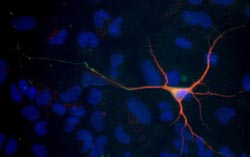Taking the fate of stem cells in hand: RUB researchers generate immature nerve cells

The RUB researchers converted neural stem cells from the spinal cord of the mouse into nerve cells; one cell is shown here. The main projection of the nerve cell, the axon is coloured green, other projections, the dendrites, red. Nuclei are shown in blue in the illustration.<br>Image: Michael Karus<br>
RUB biologists have deliberately transformed stem cells from the spinal cord of mice into immature nerve cells. This was achieved by changing the cellular environment, known as the extracellular matrix, using the substance sodium chlorate. Via sugar side chains, the extracellular matrix determines which cell type a stem cell can generate.
“Influencing precursor cells pharmacologically so that they transform into a particular type of cell can help in cell replacement therapies in future” says Prof. Dr. Stefan Wiese, head of the Molecular Cell Biology work group. “Therapies, for example, for Parkinson’s, multiple sclerosis or amyotrophic lateral sclerosis could then become more efficient.” The team describes its findings in Neural Development.
Sulphate determines the fate of stem cells
Sodium chlorate acts on metabolism enzymes in the cell which attach sulphate groups to proteins. If these sulphates are not installed, the cell continues to form proteins for the extracellular matrix, but with modified sugar side chains. These chains in turn send out signals that define the fate of the stem cells. Stem cells can not only develop into nerve cells, but also form astrocytes or oligodendrocytes, which are, for instance, responsible for the mineral balance of the nerve cells or which form their insulation layer. What happens to the stem cells if the sulphate pattern is changed by sodium chlorate was examined by Dr. Michael Karus and his colleagues.
Positive side effects: nerve cells remain immature
The RUB-laboratories of Prof. Dr. Stefan Wiese, Prof. Dr. Andreas Faissner and Prof. Dr. Irmgard Dietzel-Meyer collaborated for the study. Using antibodies, the researchers showed that cells which they had treated with sodium chlorate developed into nerve cells. They also analysed the flow of sodium ions into the cells. The result: treated cells showed a lower sodium current than mature nerve cells. Sodium chlorate thus favours the development of stem cells into nerve cells, but, at the same time, also inhibits the maturation – a positive side effect, as Wiese explains: “If sodium chlorate stops the nerve cells in an early developmental phase, this could enable them to integrate into the nervous system following a transplant better than mature nerve cells would do.”
Bibliographic record
M. Karus, S. Samtleben, C. Busse, T. Tsai, I.D. Dietzel, A. Faissner, S. Wiese (2012): Normal sulphation levels regulate spinal cord neural precursor cell proliferation and differentiation, Neural Development, doi:10.1186/1749-8104-7-20
Further information
Prof. Dr. Stefan Wiese, Molecular Cell Biology Work Group, Faculty of Biology and Biotechnology at the Ruhr-Universität, 44780 Bochum, Germany, Tel. +49/234/32-22041
stefan.wiese@rub.de
Editor: Dr. Julia Weiler
Media Contact
More Information:
http://www.ruhr-uni-bochum.deAll latest news from the category: Life Sciences and Chemistry
Articles and reports from the Life Sciences and chemistry area deal with applied and basic research into modern biology, chemistry and human medicine.
Valuable information can be found on a range of life sciences fields including bacteriology, biochemistry, bionics, bioinformatics, biophysics, biotechnology, genetics, geobotany, human biology, marine biology, microbiology, molecular biology, cellular biology, zoology, bioinorganic chemistry, microchemistry and environmental chemistry.
Newest articles

Eruption of mega-magnetic star lights up nearby galaxy
Thanks to ESA satellites, an international team including UNIGE researchers has detected a giant eruption coming from a magnetar, an extremely magnetic neutron star. While ESA’s satellite INTEGRAL was observing…

Solving the riddle of the sphingolipids in coronary artery disease
Weill Cornell Medicine investigators have uncovered a way to unleash in blood vessels the protective effects of a type of fat-related molecule known as a sphingolipid, suggesting a promising new…

Rocks with the oldest evidence yet of Earth’s magnetic field
The 3.7 billion-year-old rocks may extend the magnetic field’s age by 200 million years. Geologists at MIT and Oxford University have uncovered ancient rocks in Greenland that bear the oldest…





















